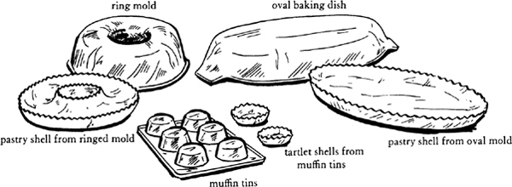Mastering the Art of French Cooking, Volume 2 (48 page)
Read Mastering the Art of French Cooking, Volume 2 Online
Authors: Julia Child

TART AND PIE DOUGHS
Pâtes Brisées—Pâtes à Croustades
DOUGH TALK
French
pastry dough is flour and butter worked together and then moistened with liquid. Liquid forces the gluten molecules in the flour to join into a continuous web so that the dough will keep its shape when rolled out; the dough must have its stated amount of liquid for this effect to take place. Butter gives the pastry its flavor and texture; as always, we suggest that about ¼ of the butter proportions be given over to vegetable shortening, which has a tenderizing effect that almost all American flours seem to need.
It is in the first step, working the butter and flour together, that many people have difficulty. Trying to do everything just right, they work too slowly and carefully, lingering over each squeeze of butter and flour until their hot fingers melt the butter; thus the liquid cannot mix in properly, and the dough is a wet, oily mess that, even after chilling, bakes into a miserable piece of cardboard. An electric food processor or mixer eliminates the problems.
ELECTRIC MIXER PIE DOUGH
PÂTE BRISÉE À L’OEUF—PÂTE À CROUSTADE
[Egg Pastry Dough for Free-standing Shells and Cases, and for Turnovers]
The following dough formula is designed especially for pastry
shells formed on upside-down tins
, an informal and wonderfully easy way to make
quiche
and pie shells. Whatever your dough formula, you can use exactly the same system outlined here.
For about 1 pound of flour, enough for three 10-inch shells
1)
Preliminaries
¾ cup liquid (1 “large” egg plus necessary ice water); ¼ to ⅓ cup more ice water as needed
3½ cups (1 lb.) all-purpose flour (
scooped and leveled
)
8 ounces (2 sticks) chilled unsalted butter
3 ounces (6 Tb) chilled vegetable shortening
2 tsp salt
¼ tsp sugar
Either an electric mixer or a food processor
Prepare the liquid and extra ice water. Measure the flour into the machine. Rapidly cut the butter into 4 lengthwise strips, then into ¼-inch pieces, and add to the flour along with the chilled shortening, and the salt and sugar. Plan to work rapidly so ingredients remain chilled—if you have to stop for any reason, place everything in the refrigerator until you can continue.
2a)
Making the dough in an electric mixer
(If your electric mixer comes with a flat beater, so much the better; otherwise use the whisk-whip attachment)
A pastry scraper or rubber spatula
Plastic wrap
A little flour, as needed
A plastic bag
Run the machine at moderate speed, pushing fat and flour into the blades with a rubber spatula (if you are using a home-model whisk-type mixer). The object here is to break the butter into pieces less than
1
⁄
16
inch in size, each piece coated with flour. Then pour ¾ cup of liquid into the flour and beat a few seconds at moderate speed, just until dough has absorbed liquid and clogs in the blades—add up to ¼ cup more ice water by dribbles if needed. Turn the massed dough out onto the plastic; sprinkle droplets of ice water on any unmassed bits in the bowl, and press together as you add them to the rest of the dough. With lightly floured hands, press the dough into a roughly shaped cushion, wrap in plastic, and chill in the plastic bag. Proceed to Step 3.
2b)
Making the dough in an electric food processor
A pastry scraper or rubber spatula
Plastic wrap
A plastic bag
(If you have a small—under 2-quart—container, divide ingredients in half and make the dough in 2 batches.) Flick the machine on and off 4 to 5 times to blend dry ingredients and butter. Turn the machine on and pour in the ¾ cup of liquid. Flick the machine on and off several times and the dough should begin to mass on the blade. If not, dribble in a little more water and repeat, repeating again if necessary. Dough is done when it has begun to mass; do not overmix it. Scrape the dough out onto your work surface, and with the heel of your hand smear it out by 2-tablespoon bits—making a 6-inch sweep (this is the final blending). Gather it into a rough cushion shape, wrap in plastic, and chill in a plastic bag. Proceed to Step 3.
3)
Chilling the dough before forming—about 2 hours
Once dough has been mixed, it must be well rested and chilled before you roll it out. The rest relaxes the gluten in the flour, so the dough will roll easily; chilling firms the butter, giving the dough enough body for rolling. In all of the following procedures, keep the dough chilled—it is impossible to work with otherwise; refrigerate it even in the midst of rolling.
(*) Dough may remain in refrigerator several days, or may be frozen for several months.
UPSIDE-DOWN PASTRY SHELLS AND CASES
The classic free-standing French pastry shell is formed by rolling out the dough and pressing it inside a flan ring or mold. The dough is then braced in place with another mold or with buttered foil and dried beans so that it will not collapse during baking. This method is illustrated in Volume I, pages 141–6, and produces the most professional result.



